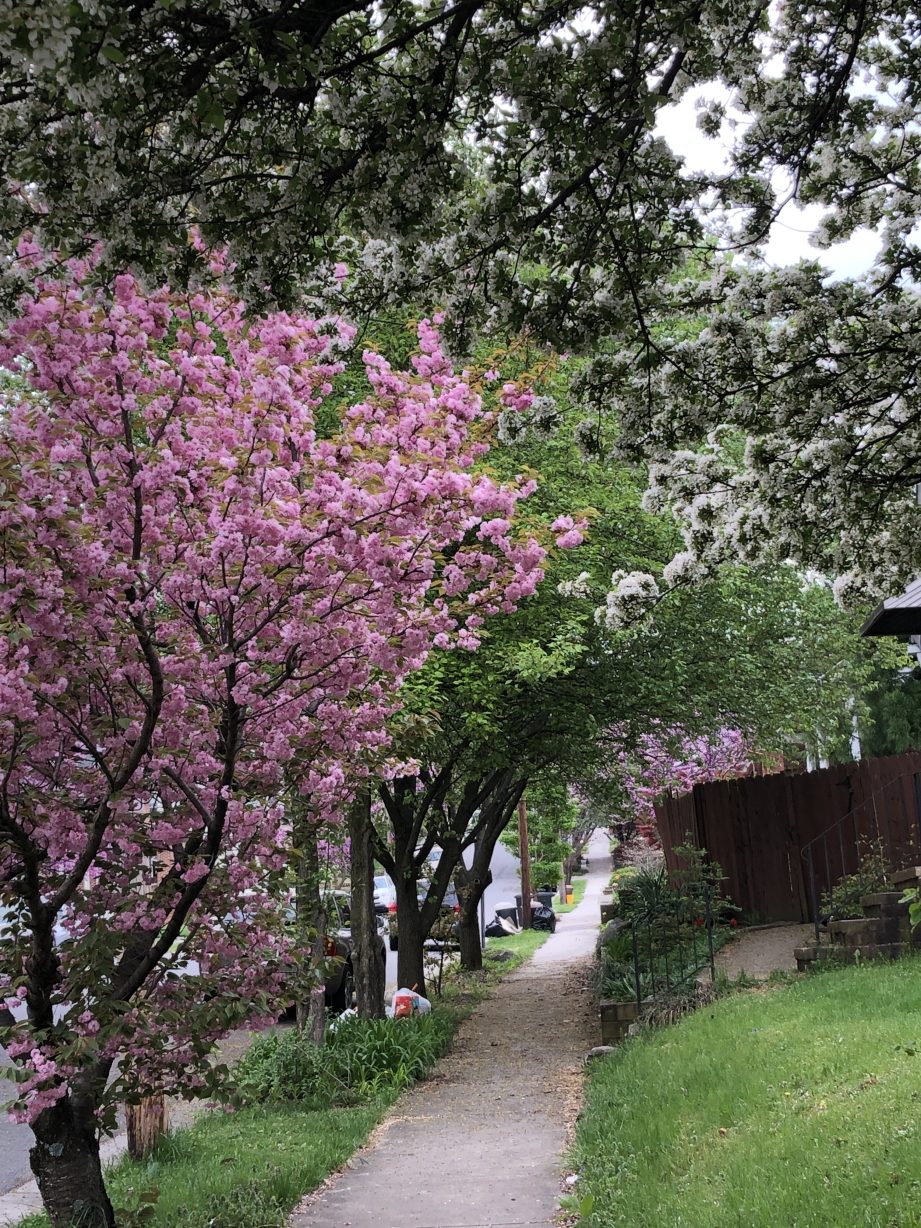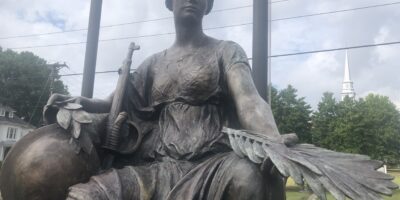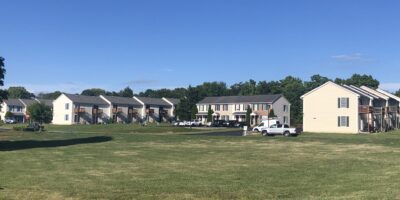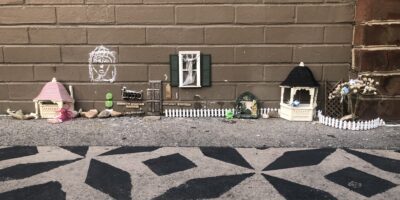
By Sofia Samatar
“The Friendly City” is a weekly column about walking in Harrisonburg that will run during 2024. Each week, your friendly correspondent, writer and teacher Sofia Samatar, will reflect on a walk in our city.
Season of lushness. Everything green, burgeoning. You go down certain streets you know, the ones with the big old houses where the students live. Tangles of fairy lights and streamers hang from the pillared porches, knots and tatters like overburdened branches.
This transient feeling, a sense of exuberant life. Students on the porches, it’s eighty degrees and cloudy, it’ll rain later, now there’s a thin sun, they’re laughing, swinging lazily in hammocks, tossing empty bottles down to glint in the grass, and what’s this joy?
These houses are so spacious, so handsome, they almost look imposing—but then suddenly there’s a bent awning streaked with rust, or a crude spraypainted stone in the yard, or a flight of crumbling steps with the tiles falling off. Once you’ve identified the place as a student house, it loses its grandeur. It comes down to earth. The walls are bashed about the edges, roughly used like old soccer cleats. You notice the bare, scrubby yards, the peeling trim exposing layers of paint, the bushes chopped back with a careless hand. A red plastic cup in the weeds reminds you of how you once saw a hired yard worker casually mowing over such cups in one of these yards, his fixed gaze expressing infinite boredom, his machine spitting out splinters of red and white plastic along with the grass.
Neglected buildings, unloved and shabby, serving temporary tenants. Yet there’s something wonderful about the student houses: a distinctive energy, perhaps more intense for being seasonal, that adds its special zest to the city. The students give names to their houses and paint them on signs: Uptown, Narnia, the Funk House, the Tree Haus, the Planetarium. They fill the porches with sagging couches, lock their bikes and scooters to the railings, decorate the doors with weird ornaments: gaping dolls or plastic skulls. Here’s the Full House, proudly announcing Established in 1905. Dandelions spangle the yard like scattered coins. Here’s a tire swing on a rope, a folding chair face-down on the grass, a sunroom crammed with exercise equipment.
The Friendly City is home to two universities. Students make a difference in this modest town, swelling and shrinking the population in ways that can’t be missed, as the Bradford pear trees thicken with starry, funky, unruly blossoms. Every autumn the city releases a collective, fairly good-natured groan: The students are back! Traffic clots; café tables fill; lines for weekend brunch snake down the street. And now, in spring, as the students begin to decamp, you can feel the migration, an increased bustle and tension in the air. Bags of trash pile up on the curb. Flattened cardboard boxes lean against steps or splay in the driveways, softened by rain.
What’s this joy? It’s not relief that the students are going away—on the contrary, you’re charmed by their presence, their vitality, amused even by their invasion of parking spots, their distracted driving, their reckless habits on skateboards and scooters, their noise. So what explains the buoyancy you feel on your walk, passing houses already deserted by their inhabitants, the curtainless windows exuding a lonely air, the grayish wood of the porches bare but for a stray plastic crate or a stack of two-by-fours? The can of hairspray, the broken sink, the blinds slung at a crazy angle—why does happiness flow from such sad things? It must be a feeling of possibility, you think, rounding the corner: a sense of openness, of potential.
Transience of the spring flowers, transience of the students, transience and lushness of the season. They are going away, moving on, perhaps temporarily, to study abroad or spend the summer at home, perhaps for good, making their way uncertainly to other places, to unfamiliar demands and a new sense of time. Those who have left school will begin to live by a different clock: not the regular, cyclical ebb and flow of the semester system, but the steady stream of workdays laid like train tracks to the horizon or the rushed and panicky rhythm of underemployment. Most will not have again the feeling of happy transitoriness, something they’ve taken for granted up to now, the sense that things are ending and it’s right that they should end, as summed up in the common expression “It’s just a phase.” At some point, one ceases to be offered the grace of living in phases, you think, passing a yard where an overflowing trash can tilts on a mound of refuse, something the city’s inhabitants are (just) willing to tolerate from students but would never stand for in a long-term neighbor.
It’s right, of course, that custom puts an end to the period when such behavior can be excused as a phase. And yet one does not cease to change. Maybe that’s the secret of the sparkling feeling that fills you as you walk past these forsaken, junk-strewn porches. If the hills of the Friendly City offer an altered experience of space, the student houses do the same for time. Climb a rise to look out on the blue folds of the mountains; contemplate the torn screen of a house marked Off-Campus Housing for Rent to renew, for a moment, your sense of the future.










